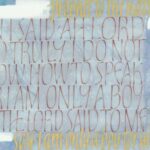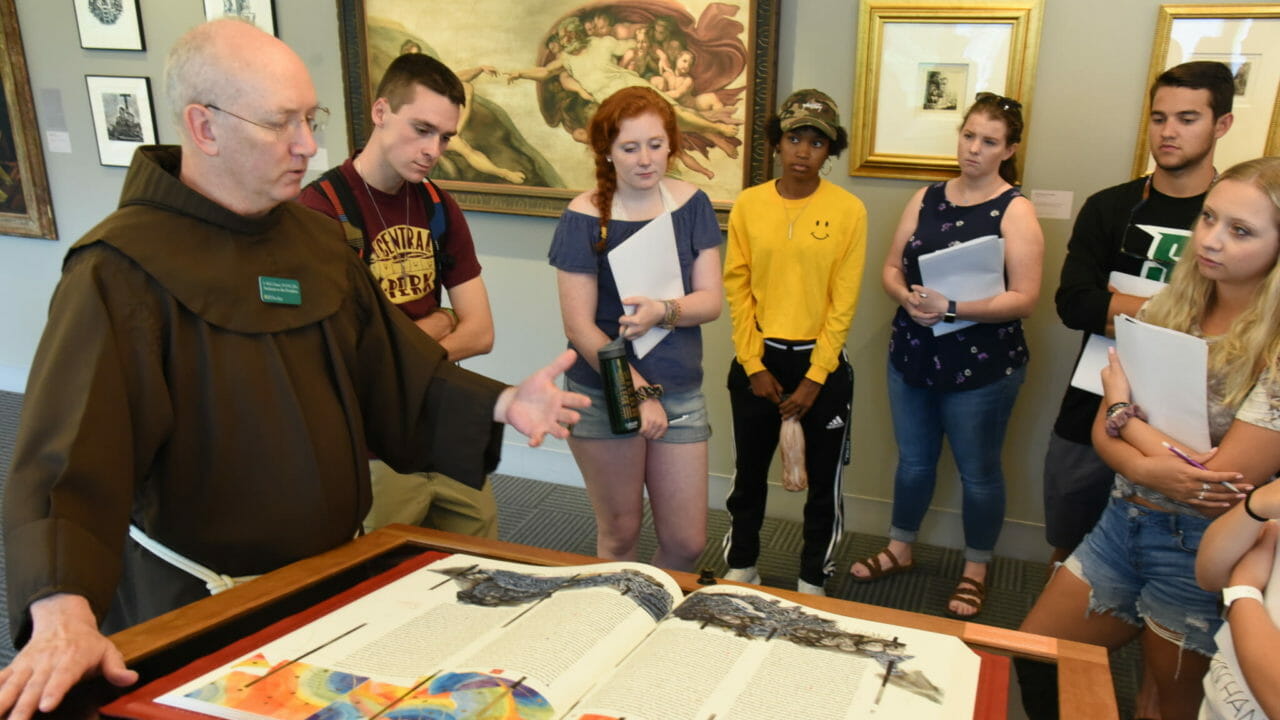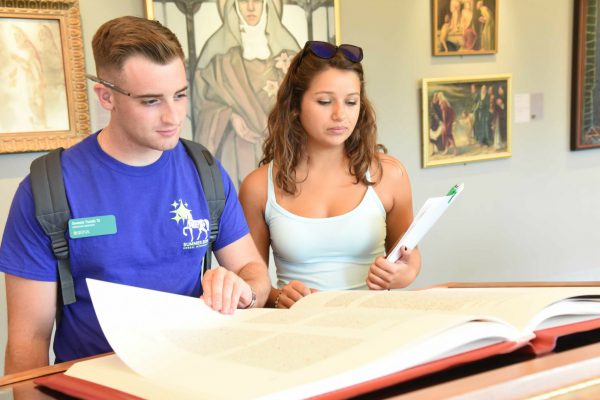Franciscan Tradition is “Alive” with the Heritage Edition at Siena College
How the NY liberal arts college moves from “coexistence to communication to cooperation” to use the Bible
Every faith tradition has its tangible representations of an intangible belief: symbols, texts, and even elements of nature can center one’s faith and serve as a reminder of traditional values and figures. But to Siena College in Albany, New York, the important part of owning The Saint John’s Bible isn’t to show it off as ‘proof’ of faith or tradition.
“There’s not one thing that says that Siena is Catholic or one thing that says we’re Franciscan,” says Fr. Mark G. Reamer, OFM. Reamer leads Siena’s Mission Office, which was responsible for bringing the Heritage Edition to campus.
“I think it’s a lot of things,” he continued. “When you walk on a campus, you should know something about the campus even before you meet people, in terms of the artwork, the statuary, the way buildings are designed and spaces to gather people, and the architecture. So how do you design something that brings people together? I think [The Saint John’s Bible] is one more way of helping to highlight our Catholic identity as a college.”
What’s important to Siena College is that the Heritage Edition gets used; that it’s seen; that it’s understood – or as close as we can get to an understanding of the Word of God.
The Heritage Edition Inspires a Spirit of Creation at Siena College

Reamer knew that the college wanted to own its Heritage Edition from the start, but the team also didn’t want to risk having it sit around, unseen and forgotten. “We were able to secure a generous grant from the The John, Joseph and Marie Whalen Foundation, which helps to promote Catholic identity in the diocese of Albany, and that was our lead grant thanks to brother-sister team Phil and Mary Whalen,” he said. “And then in addition, we wanted to create an endowment so that the Bible would not sit in a closet. We want it to be used and utilized, and so the endowment will allow a few dollars to trickle out every year to make sure that it’s dusted off and is being utilized and we have the upkeep that we might need and things like that.”
To that end, the Heritage Edition’s volumes will have homes in different locations around the Siena campus, with one on hand for loan within the local diocese. As for the remaining six, Reamer said: “As you wander the campus, you would be able to see the Bible in different locations and different people would take responsibility for turning a page. As you wander the campus, you would be reminded of the sacred word.
“My hope is that as many people as possible will take ownership of the Bible so that it’s not just one person saying, ‘Oh, that’s the library’s project,’ or ‘That’s Father Mark’s project.’ No, that’s our project, it’s everybody’s project,” said Reamer. “For a collaboration to happen, you’ve got to move from coexistence to communication to cooperation, so instead of it being everybody in their own silo, let’s talk about how we can use it and cooperate and that’s how collaboration comes about.”
Tim Reno, Associate Professor of Creative Arts, became part of that collaboration when he saw the Luke frontispiece in Siena’s Heritage Edition. “Any piece of music could have inspired the committee and the artists in their process,” he said. “But what would happen if we had an opportunity for these illuminations to inspire new music?”
A choral composition competition was born from that very concept: composers from around the world were asked to compose an original choral work inspired by art from The Saint John’s Bible to be performed by Siena’s chamber choir, the Clare Ensemble Singers. “The composers ranged from high school students to full-time professional composers from all over the country, and in addition to their music, they were asked to contribute a statement about how their work engages with The Saint John’s Bible,” Reno said. Two pieces were selected – Your word is a lamp by Alan MacMillan, followed by Joe Elephante’s runner-up Fluminis – and the Heritage Edition continues to inspire Siena’s concert series. “The Creative Arts Department is thrilled to have this amazing work on campus, and we are always looking for new ways to use it,” said Reno.
The Bible has found its way into the classroom, as well, with help from Peter Zaas, Professor of Religious Studies: “The physicality of The Saint John’s Bible, with its backstory, the processes of its creation, the bookmaking and scribal arts that it embodies, gave students a new perspective – or helped them recover an old one – on books,” he said. Zaas modeled one of his courses on the art and scripture of The Saint John’s Bible just last semester, choosing passages that “enhanced the classroom conversation.”
“The illustrations are excellent conversation-starters for students who have a visual bias,” Zaas said, “and gives them the (correct) impression that Siena is a special place, with a special place for Scripture within it.”
Living Franciscan Values through an Inter-Religious Work of Art
Reamer remarks on the various ways Siena students, faculty and staff have worked with and around the Heritage Edition: “I couldn’t have imagined the different ways the Bible was going to be used, because people had very different ways of doing it.” No matter how disparate their execution may have been, their intent was the same: provide the campus with another tool for living their Franciscan values.
“Saint Francis was known for his love of Jesus,” Reamer said. “Of course, every saint was, but in particular, for Francis, it was the nativity of Jesus taking on our flesh, and so we’re known for making it real, and I think that The Saint John’s Bible helps to make the word real and to bring it alive.”



